click on images to enlarge
Japanese Influence in American Silver 1870-1890
In 1853, Commodore Matthew C. Perry, sailed into Tokyo Bay and after
a show of force, Perry convinced Japanese authorities to sign the Treaty
of Kanagawa on March 31, 1854.
The pact led to significant commercial trade between the United States
and Japan, but it also contributed to opening up Japan to other Western
nations. Before 1853, for centuries Japan had been a closed society.
The few objects of Japanese art to arrive in Europe, were bought in
China. In few years, Japanese objects started to appear in large
quantities and people started to visit Japan.
The influence of Japanese art and design grew enormously in those years
in Europe and USA. The Japanese style was so original and elegant that
it became an huge success in the Western World.
One example was the English designer Christopher Dresser (1834-1904).
Dresser arrived in Japan in 1876. He spent four months observing
artists, potters and metalworkers and came back to England with a
newfound philosophy of design that affected metalwork, furniture,
ceramics, textiles, wallpaper and cast iron.
The designs were an instant hit in Europe. In the same time, in the USA,
Tiffany and Gorham began to break free of European influence and looked
to the East for inspiration.
The Philadelphia Centennial Exhibition of 1876, in which a large amount
of Japanese crafts were presented to the public for the first time, had
an huge influence on the growth of popularity of Japanese Style in USA.
Tiffany's change of heart was directed by their new president and chief
designer Edward C. Moore. Edward Moore was a keen orientalist and
collector of the Japanese art. He started to experiment not only with
Japanese design but also with new tecniques of metalwork influenced by
the Japanese crafts.
Silver, copper, brass and gold were used together in the same piece with
very elaboate designs. Natural elements like animals and plants were
used:
gourd-shaped teapots and coffeepots crawling with insects; pitchers,
flasks, and bowls with fish, frogs, crabs, and turtles making their way
up their sides.
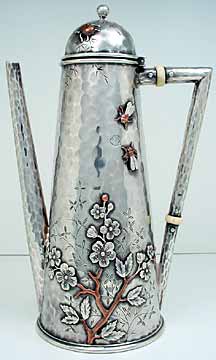
This is an example of a coffee pot in Japanese style with copper
ground applied silver decoration and mounts. |
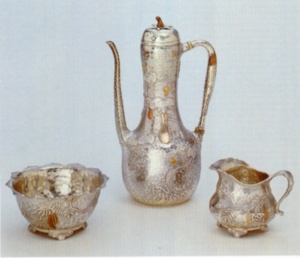
Another example of a tea set made by Tiffany in 1877 is shown on the
left. Here the base surface is hammered silver on which naturalistic
elements made in brass, gold and silver have been applied.
|
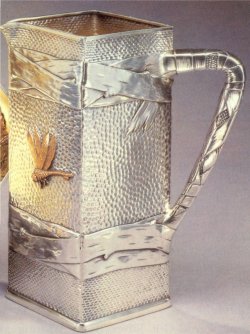
The Tiffany articles produced in this period are marked with an 'M'
to recognize the importance of Moore. Tiffany was not the only
company producing items with mixed metal techniques. Gorham also
produced beautiful items and was often in competition at the
International Exhibitions like the one in Paris in 1878. This is an
example of the silver water pitcher produced in 1878 by Gorham. |
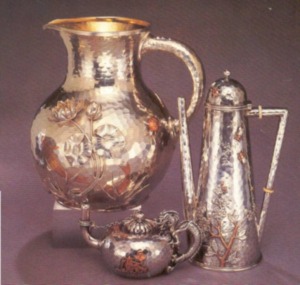
Another company, who produced items in this style, was Whiting
Manufacturing Company (New York). Below there is an example of
objects produced by Whiting. The large water pitcher and the
Demi-Tasse Pot are from Whiting (1880-1890), while the small Lighter
at the bottom of the picture was produced by Gorham in 1882.
|
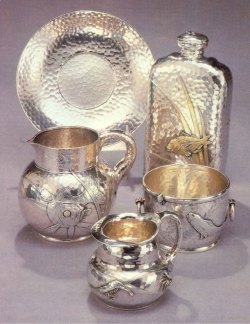
Other examples of Japanese Style pieces by Tiffany are shown below.
|
Towards 1890, the shift from oriental-style designs to the fluidity
of Art Nouveau was gradual but inexorable and the main companies stopped
producing items with mixed metal and they tried to experiment with new
techniques like Gorham with 'Martele' silver.
Items in mixed metals from Tiffany, Gorham and other companies are very
rare and sought after. They appear occasionally at auctions and they
always fetch high prices.
Gianmarco Baldini - 2005 -
|